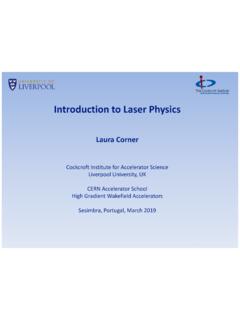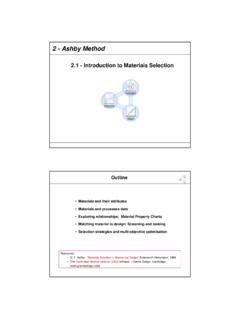Transcription of ISO and EIGA standards for cryogenic vessels and ... - Indico
1 ISO and EIGA standards for cryogenic vessels and accessories CERN, Geneva September 22nd, 2016 l Herv Barth l my, l Air Liquide Gas Packaging Center Contents Introduction Material issues Cold stretching Legislative and normative frameworks European Industrial Gases Association ISO/TC 220 cryogenic vessels Future work at ISO/TC 220. 2 Date Doc title World leader in gases, technologies and services for Industry and Health Introduction Different types of cryogenic vessels : Vacuum insulated / non-vacuum insulated Static / transportable 3 September 2016 H. Barth l my World leader in gases, technologies and services for Industry and Health Introduction Used for more than 40 years for the storage and transportation of industrial and medical gases In a volume of 1L of liquid, about 800L of gas can be stored X The gases need to be refrigerated down to very low temperatures to be in liquid form Gases CO2 Kr O2 Ar Air N2 Ne H2 He Boiling temperatures ( C) -153 -183 -186 -191 -196 -246 -253 -269.
2 Boiling temperatures at atmospheric pressure of different gases Necessary to use high efficiency vacuum insulated vessels 4 September 2016 H. Barth l my World leader in gases, technologies and services for Industry and Health Material issues Materials issues ( for liquid hydrogen). Hydrogen embrittlement (-150 C) - Warm (vessel almost empty). Compatibility of metals and alloys with low temperatures, in particular: Brittleness Thermal conduction Expansion and contraction phenomena Condensation of liquid air in the interspace (50/50 O2-N2). 5 September 2016 H. Barth l my World leader in gases, technologies and services for Industry and Health Material issues Metallic materials commonly used Source: ISO 21010 cryogenic vessels - Gas/materials compatibility 6 September 2016 H. Barth l my World leader in gases, technologies and services for Industry and Health Cold stretching Reducing the wall thickness of the vessels -> cold stretching stress / strain curve for carbon steel stress / strain curve for austenitic stainless steel Permanent plastic deformation Improvement of the yield strength Reduction of the wall thickness (weight, cost).
3 7 September 2016 H. Barth l my World leader in gases, technologies and services for Industry and Health Legislative and normative frameworks Regional International Legislative PED, TPED UN. Standard CEN ISO. Industry EIGA, CGA IOMA. 8 September 2016 H. Barth l my World leader in gases, technologies and services for Industry and Health European Industrial Gases Association European and a number of non-European companies producing and distributing industrial, medical and food gases. EIGA/WG-6: cryogenic vessels (& accessories). Design, material compatibility, operational requirements and periodical inspection To monitor international standardisation (ISO, CEN) and regulations (UN, TPED, PED) to prepare Codes of Practice or guidelines To review accidents and incidents, to determine the causes and to propose ways to avoid re-occurrence 12 documents (incl. 4 harmonized with CGA). 9 September 2016 H. Barth l my World leader in gases, technologies and services for Industry and Health EIGA documents Doc.
4 N Title Applies to H2, He? Doc. 06/02 Safety in storage, handling and distribution of liquid hydrogen H2. Doc. 07/14 Metering of cryogenic Liquids Doc. 24/08 Vacuum insulated cryogenic storage tank systems pressure protection devices Doc. 114/09 Operation of static cryogenic vessels H2,He Doc. 115/12 Storage of cryogenic Air Gases at User's Premises Doc. 119/04 Periodic inspection of static cryogenic vessels H2, He Doc. 151/15 Prevention of Excessive Pressure during Filling of cryogenic vessels H2, He Doc. 159/14 Reciprocating cryogenic Pumps and Pump Installations Doc. 164/10 Safe handling of liquid carbon dioxide containers that have lost pressure Doc. 168/11 Calculation Method for analysis and prevention of overpressure during Refilling of cryogenic Tanks with Rupture Disks PP 09/09 The Pressure Equipment Directive. Periodic Inspection and Reassessment of H2, He Rev 1 static cryogenic vessels for use in the European union TB 11/14 Recommendations for the Prevention of Brittle failure of the Outer Jacket of H2, He Vacuum Insulated cryogenic Storage Tanks 10 September 2016 H.
5 Barth l my World leader in gases, technologies and services for Industry and Health European Industrial Gases Association Doc. 06/02 - Safety in storage, handling and distribution of liquid hydrogen Guidance of companies for the installation of liquid hydrogen storage at the user's premises and the distribution of liquid hydrogen by road, rail and sea transport. A liquid hydrogen storage installation on a user's premises is defined. It applies to the layout, design and operation of such fixed storages and the transportation of liquid hydrogen in bulk form by tankers or tank containers, by road, sea and rail, to fixed storages at user's premises. Portable containers, such as pallet tanks and liquid cylinders, are excluded from the scope of this document. 11 September 2016 H. Barth l my World leader in gases, technologies and services for Industry and Health European Industrial Gases Association Doc. 114/09 - Operation of static cryogenic vessels Specifies the procedures for putting into service, inspections, requalification according to the PED, taking out of service, maintenance and repair of static cryogenic vessels designed for a maximum allowable pressure of more than barg.
6 Describes the operation of static cryogenic vessels , putting into service, inspections, taking out of service, maintenance and repairs and includes: How the user operates the vessel How local authorities and competent persons inspect these vessels to get common agreement about the operation that allows free movement within Europe without additional approvals 12 September 2016 H. Barth l my World leader in gases, technologies and services for Industry and Health European Industrial Gases Association Doc. 119/04 - Periodic inspection of static cryogenic vessels Periodic inspection and testing of static vacuum insulated cryogenic pressure vessels used in the storage of refrigerated liquefied gases, excluding toxic gases. The PED only covers design, manufacturing and placing on the market. The national legislations and practices for periodic inspection and testing varies considerably between European countries (even for similar vessels on similar services).
7 Doc. 151/15 - Prevention of Excessive Pressure during Filling of cryogenic vessels Guidance for the filler/owner of either transportable or static cryogenic tanks, detailing the systems and procedures that can be used to prevent them being over pressurized during filling. To address the issue of receiving vessels greater than 1000 L water capacity. Also used for receiving vessels under 1000 L that are not designed for transport when full. Guidance for other products and other transfer systems. 13 September 2016 H. Barth l my World leader in gases, technologies and services for Industry and Health European Industrial Gases Association TB. 11/114 Recommendations for the prevention of Brittle Failure of the Outer Jacket of Vacuum Insulated cryogenic Storage tanks Risks to consider : Hidden failure due to differential thermal expansions within piping Brittle fracture due to imingment of cryogenic fluids onto the outer jacket PP 09/09 The PED Periodic Inspection and Reassessment of Static cryogenic vessels for use in the EU.
8 The conditions for the periodic inspections are very different from member state to member state of the EU. No mutual recognition of the periodic inspection performed in another country The PP gave the future action to be considered at the European level. 14 September 2016 H. Barth l my World leader in gases, technologies and services for Industry and Health ISO/TC 220 cryogenic vessels ISO/TC 220: cryogenic vessels Standardization in the field of insulated vessels (vacuum or non-vacuum) for the storage and the transport of refrigerated liquefied gases of class 2 of "Recommendations on the Transport of Dangerous Goods - Model regulations - of the United Nations", in particular concerning: the design of the vessels the operational requirements of the equipment and accessories the supporting standards (safety accessories, gas/materials compatibility, insulation performance ). 15 September 2016 H. Barth l my World leader in gases, technologies and services for Industry and Health ISO/TC 220 - Structure ISO/TC 220.
9 cryogenic vessels Secretariat : AFNOR. Chairperson: HB. WG 1 WG 2 WG 3. Design and construction Operational requirements Supporting standards Secretariat : AFNOR Secretariat : DIN Secretariat : CGA/ANSI. Convenor: HB. 20 published ISO standards under the direct responsibility of ISO/TC 220. 16 September 2016 H. Barth l my World leader in gases, technologies and services for Industry and Health ISO/TC 220 - standards Large transportable vacuum- insulated vessels Static vacuum-insulated ISO 20421 series vessels vessels Transportable vacuum-insulated ISO 21009 series vessels 1000L. ISO 21029 series Valves Hoses Pressure relief accessories Pumps Accessories ISO 21011 ISO 21012 ISO 21013 series ISO 24490. Gas/materials compatibility Toughness requirements for materials ISO 21010 ISO 21028 series Insulation Cleanliness for cryogenic service ISO 21014 ISO 23208. 17 September 2016 H. Barth l my World leader in gases, technologies and services for Industry and Health ISO/TC 220 standards for cryogenic vessels ISO 20421 series Large transportable ISO 21029 series Transportable vacuum vacuum insulated vessels insulated vessels Part 1: Design, fabrication, Part 1: Design, fabrication, inspection and testing inspection and testing Volume > 450L Volume 1000L.
10 Does not apply to toxic fluids Does not apply to toxic fluids Permanently (fixed tanks) or not Permanently (fixed tanks) or not permanently (demountable tanks and permanently (demountable tanks and portable tanks) attached to a means of portable tanks) attached to a means of transport, for one or several transport, for one or several Part 2: Operational requirements Part 2: Operational requirements Putting into service Putting into service Filling, withdrawal Filling, withdrawal Transport within the location, storage Transport within the location, storage Maintenance, periodic inspection Maintenance, periodic inspection Emergency procedures Emergency procedures 18 September 2016 H. Barth l my World leader in gases, technologies and services for Industry and Health ISO/TC 220 standards for cryogenic vessels ISO 21009 series Static vacuum insulated vessels Part 1: Design, fabrication, inspection and testing Part 2: Operational requirements Installation Putting into service Filling, withdrawal Transport within the location, storage Maintenance, periodic inspection Emergency procedures 19 September 2016 H.












